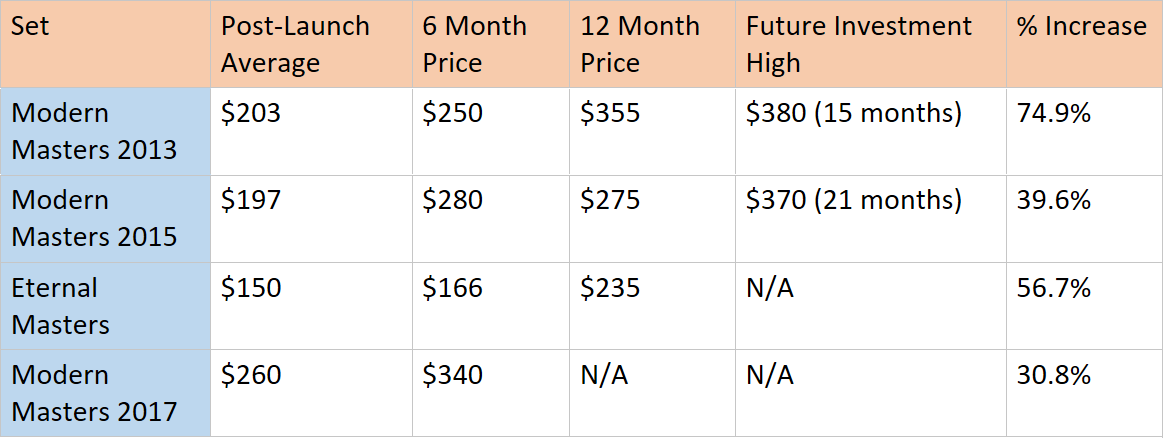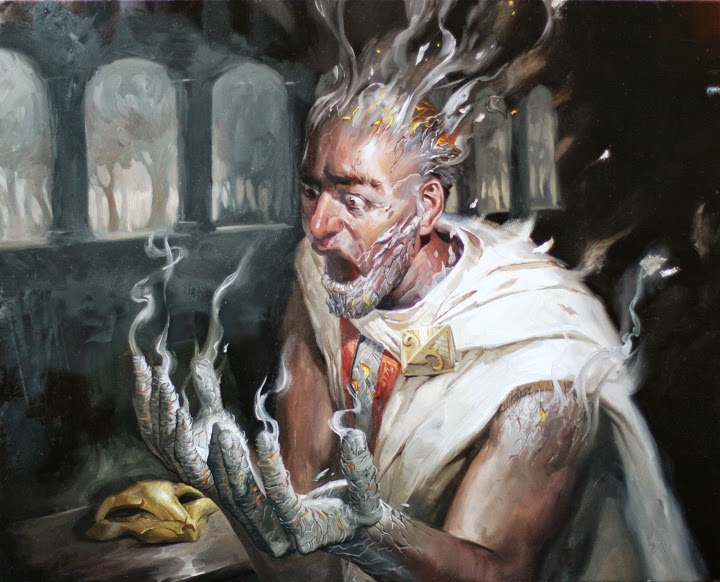Are you a Quiet Speculation member?
If not, now is a perfect time to join up! Our powerful tools, breaking-news analysis, and exclusive Discord channel will make sure you stay up to date and ahead of the curve.
Historically, Masters sets have been among the favorite stomping grounds of MTGO investors. Although requiring more initial capital, the prospect of high-dollar returns have been enticing. However, the MTGO landscape has changed fundamentally over the past year. With the introduction of treasure chests and the decision to release multiple reprint sets each year, we have to reevaluate old wisdom. In this article, I'm going to try to arm you with some knowledge that will help you make smart investments in Iconic Masters cards.
I. Financial Histories of Past Masters Sets

I was a bit struck from this research, as my image of the Masters sets' pasts were a bit rosier than reality. While all the sets did exhibit post-launch growth, that growth tended to be slower than I had imagined, and certainly slower than the growth that Standard sets exhibit once they cease to be drafted. Historically, Masters sets have grown by about 50 percent over their first year, and usually peak sometime during their second year. I expect the growth to slow by a moderate amount if Wizards continues to release two Masters sets instead of one.
For those of you who invest in entire sets, the above graph suggests that you should stick to Standard sets. Not only is the rate of return higher, but that investment strategy is backed up by something more tangible and predictable (redemption) than competitive Eternal demand. I thus believe that the best way to invest in Masters sets is to invest in individual speculation targets.
II. Reprints and Treasure Chests
Before investing into Iconic Masters, it's important to know some of the risk involved in the new current reprint-heavy environment. Three of my Modern Masters 2017 investments offer cautionary tales. The first, Griselbrand, was a card I was pretty excited to invest in...until it was announced that Iconic Masters would feature hallmark Dragons, Demons, Angels, Hydras, and Sphinxes from across all of Magic's history. And what Demon besides Lord of the Pit would merit a spot in such a set more so than Griselbrand? Fearing such a reprint, I sold mine at the first opportunity I had. If Masters sets continue to be released twice a year, especially under themes like "Iconic" or "Celebrating 25 years of Magic," selling in fear will become a more common occurrence.
Second, Restoration Angel. This was one of my favorite speculation targets from Modern Masters 2017, but this target got wiped out once it became known that it would be in Iconic Masters. Fortunately, I quickly sold it at exactly the same price at which I had invested in it, but even that result was extremely disappointing. And if I had been away on HASCON weekend, I would have lost money on that speculation.
Third, Voice of Resurgence. When making a decision on how best to allocate my resources for investment in Modern Masters 2017, I intentionally did some that were more risky, and others less risky. The final decision I made was to invest in Voice of Resurgence. Voice is a powerful card whose price had been high in part due to a dearth of supply. I liked that it was only receiving a printing as a mythic, and I felt that if the Modern metagame swung a certain way, or if something in the future was printed that would make Voice more of a Modern staple, I would be rewarded immensely. While that risk might still pay off, its chances are hurt by its (strange) inclusion on the treasure chest curated list mere months after its Modern Masters 2017 printing. Because of its lower overall supply, its price is being hurt by the treasure chest inclusion to a greater degree – it's basically receiving a full second reprinting this treasure chest cycle.
In light of the Voice of Resurgence tale, I wanted to find out which cards from Iconic Masters are curated card favorites – and my findings surprised me.
I was quite surprised to see that the vast majority of the valuable cards in Iconic Masters had not been taken off the curated list and given a figurative chance to breathe. This group of cards is burdened as a ship sailing ahead despite having dropped an anchor.
In the past, it was correct to view Masters sets as offering a temporary discount to cards that had been, and would become, more expensive. But what constitutes a good investment in a Masters set has now changed. No longer do you need to merely identify what will be a card that will be used extensively in an Eternal format – you need to identify cards that will be used more extensively in the future than they have been in the past. That could take the form of a metagame call – will Abzan and Jund Midrange decks make a resurgence next year in Modern? If you believe so, perhaps Thoughtseize is a worthy investment. Will controlling shells make a comeback in Modern? If so, perhaps you'd be willing to risk capital on Anger of the Gods or Ancestral Visions. Will Deathrite Shaman be banned in Legacy? If so, what cards might take up a higher share of the Legacy metagame?
Those are the types of questions I think you will need to answer, and have enough confidence in your answers to risk financial capital on them, to invest in Iconic Masters successfully. Phrased differently, I don't think you should invest conservatively in Masters sets anymore. And as those of you who read my articles know by now, I tend to invest fairly conservatively, using the natural cycles of sets' lows and highs to minimize risk. Occasionally I'll make metagame calls (my summer speculation on Kalitas, Traitor of Ghet comes to mind), but that's a minority of my investment decisions. More so than investments into Standard cards, I think you'll want a deep and extensive knowledge of Eternal formats, and an ability to predict how the metagames will manifest themselves over the coming months, to invest in Iconic Masters.
Signing Off
Here is a copy of my investment portfolio. No real changes from last week. If you want me to do a review of certain Iconic Masters cards for next week's article, do let me know. If I don't detect significant interest, I'm likely to next do a reflective piece looking over the year's mistakes and what I am learning from them. Also, how are y'all finding Iconic Masters? And do you plan on investing in it? I'm curious to hear your response to my article and see how others are approaching Iconic Masters from a financial perspective.






I can tell you from a play standpoint I have drafted Iconic Masters on MTGO a lot and it’s very fun; however, from a financial standpoint, I saw all I needed to see when I was hoping to open a Mana Drain in pack 3 for a Blue/Black control deck and I did just that… and then proceeded to take a common over it when I saw it was only 2 tix. I think the best play is to treat it like a “flashback” draft format and purchase all of the relevant format defining cards (Thoughtseize, Mana Drain, Ancestral Vision, Cryptic Command, etc.). Same cycle as always, people sell cards to draft while the set is out, then the cards creep back up over time. I wonder if purchasing Iconic Masters boosters has any value long term (I wonder the same of the other Masters sets, something I didn’t pay attention to previously was pack prices).
That’s a good angle that I didn’t think to analyze – how good of an investment are the boosters? I suspect that you and Matt are right – perhaps a good approach to investing in Iconic Masters could be to invest in the booster packs once the set is no longer draftable. Thanks for sharing your thoughts
I agree with George Tudor, I have been drafting a ton of this set and it’s fun! I also agree with his strategy; target the format staples, though I would shy away from Mana Drain and Ancestral Vision. I think there won’t be big short terms gains on these cards, except if there’s a big shift in the Modern format. But if you are looking 6+ months out, I think they will work out fine.
IMA boosters are another question. I think they will be worth buying, but only after you can’t draft the set anymore and the price has dropped. 2-3 tix would seem like a snap buy.